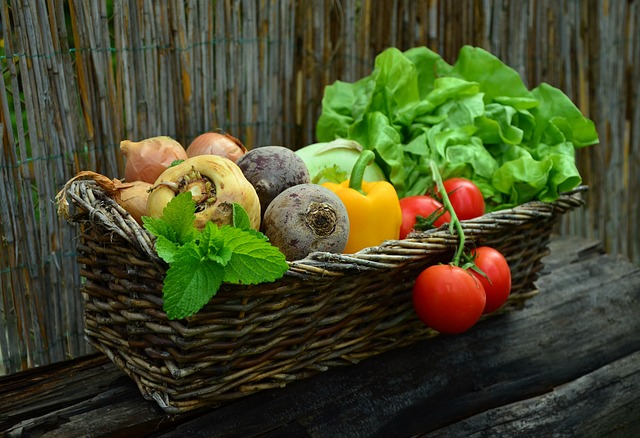Savor the Simple Joy of Seasonal Eating from Your Garden
There are some affiliate links below, but they are all products I highly recommend. For more info, view my disclosure here.
Do you want to experience the simple joy of eating fresh, delicious fruits and vegetables straight from your own garden?
Eating seasonally not only brings immense satisfaction, but it also offers a multitude of benefits for your health and the environment.
Imagine savoring the burst of flavor from a homegrown tomato or the crispness of a just-picked cucumber.
By planning and preparing your garden with the right fruits and vegetables, you can easily enjoy a diverse range of produce throughout the year.
Caring for your plants with love and attention will ensure they thrive and provide you with an abundant harvest.
And once your garden is flourishing, you’ll learn the art of harvesting and storing your produce to savor its flavors year-round.
So, why not embark on this fulfilling journey of growing your own food and maximizing its taste with seasonal recipes?
Get ready to embrace the simple joy of eating seasonally from your garden.
The Benefits of Eating Seasonally
You’ll love the burst of flavor and freshness that comes from biting into a juicy, sun-ripened tomato straight from your garden. Eating seasonally has numerous benefits that go beyond just taste.
When you choose to eat fruits and vegetables that are in season, you are consuming produce at its peak of ripeness, which means it’s packed with nutrients. The longer produce sits after being harvested, the more nutrients it loses. By eating seasonally, you ensure that you’re getting the maximum nutritional value from your food.
In addition to being more nutritious, seasonal produce is also more environmentally friendly. When you eat locally grown, seasonal produce, you’re supporting local farmers and reducing the carbon footprint associated with long-distance transportation. Seasonal eating also encourages biodiversity, as different crops are grown and harvested throughout the year. This diversity helps to maintain a healthy ecosystem and supports the pollinators necessary for the growth of our food.
Eating seasonally can also save you money. When produce is in season, it’s abundant, which drives down the cost. Additionally, seasonal produce is often grown locally, eliminating the cost of long-distance transportation and storage. By growing your own seasonal produce, you can save even more money and experience the satisfaction of harvesting your own food.
Overall, embracing the joy of eating seasonally from your garden not only enhances your taste buds but also benefits your health, the environment, and your wallet. So why not start enjoying the simple pleasure of eating fresh, seasonal produce today?
Planning and Preparing Your Garden
Get ready to experience the pure satisfaction of planning and prepping your very own garden. It’s an exciting journey that allows you to have full control over what you grow and ultimately what you eat.
Start by choosing the right location for your garden. Look for a spot that gets plenty of sunlight and has good drainage. Clear the area of any weeds or debris, and get the soil ready by adding compost or organic matter to improve its fertility.
Once you have the perfect spot, it’s time to decide what to plant. Think about what fruits, vegetables, or herbs you enjoy eating the most. Consider the climate and seasonality of your area to determine what will thrive in your garden. Make a list of the seeds or seedlings you need to buy and create a planting schedule to ensure a continuous harvest throughout the season.
Next, gather your gardening tools and supplies. You’ll need a trowel, gardening gloves, watering can or hose, and stakes or trellises for support. Prepare your garden beds by loosening the soil and removing any rocks or clumps. Follow the instructions on the seed packets or plant tags for proper spacing and planting depth.
Water your garden regularly, keeping the soil moist but not waterlogged. Use organic pest control methods to keep unwanted critters away. As your plants grow, provide support by staking or trellising them if necessary. Finally, be patient and enjoy the process. Gardening is a labor of love, but the simple joy of eating fresh, homegrown produce makes it all worth it.
Choosing the Right Fruits and Vegetables
Once you’ve carefully considered the climate and your personal preferences, it’s important to choose the fruits and vegetables that will thrive in your specific garden space.
Start by selecting crops that are well-suited to your region’s growing conditions. Research which fruits and vegetables grow best in your area during each season. This will ensure that you have a bountiful harvest throughout the year.
When choosing your crops, think about what you and your family enjoy eating. There’s no point in growing vegetables that no one likes. Consider your favorite dishes and the types of vegetables that are commonly used in those recipes. This way, you’ll be growing produce that you’re excited to eat and share with others.
Additionally, take into account the space you have available in your garden. Some vegetables, like tomatoes and cucumbers, require a lot of room to spread out, while others, like lettuce and herbs, can be grown in smaller spaces. Plan accordingly to make the most of your garden’s potential.
Lastly, consider the time and effort required to grow certain crops. Some fruits and vegetables are low-maintenance and easy to grow, while others require more attention and care. If you’re a beginner, start with plants that are known to be resilient and forgiving.
By carefully choosing the right fruits and vegetables for your garden, you’ll set yourself up for success and the simple joy of eating seasonally from your own backyard.
Caring for Your Plants
To ensure the healthy growth of your plants, it’s essential to provide them with proper care and attention throughout their lifecycle. Start by preparing the soil before planting. Make sure it’s well-drained and enriched with organic matter. This will create a favorable environment for your plants to thrive.
Watering is crucial for plant growth, especially during dry spells. Water your plants deeply and regularly, making sure the soil is moist but not waterlogged. Mulching around the base of the plants can help retain moisture and suppress weed growth.
Regularly inspect your plants for pests and diseases. Remove any damaged or infected leaves or fruits to prevent the spread of problems. Consider using organic pest control methods, such as companion planting or natural sprays, to keep your plants healthy without harmful chemicals.
Fertilizing is important to provide your plants with the necessary nutrients. Use organic fertilizers or compost to feed your plants regularly. Follow the instructions on the packaging or consult a gardening expert to determine the appropriate amount and timing for fertilizing.
Lastly, don’t forget to provide support for your plants that need it. Install stakes or trellises for climbing plants like tomatoes or cucumbers. This will help them grow upright and prevent damage.
By following these care tips, you can ensure that your plants thrive and produce an abundance of delicious fruits and vegetables for you to enjoy. Happy gardening!
Harvesting and Storing Your Produce
When you’ve nurtured your plants with care, it’s time to enjoy the fruits of your labor by harvesting and properly storing the produce.
The joy of eating seasonally from your garden is enhanced when you know that your efforts have paid off and you can savor the freshness of your homegrown vegetables and fruits.
Harvesting your produce at the right time is crucial for optimal flavor and nutrition. Different vegetables and fruits have different signs of ripeness, so it’s important to educate yourself about each specific plant in your garden.
For example, tomatoes should be picked when they’re fully colored and slightly soft, while cucumbers should be harvested when they’re firm and a vibrant green. By carefully observing your plants, you’ll be able to determine the perfect time to harvest.
Once you’ve harvested your produce, proper storage is key to maintaining its freshness. Remember to handle your fruits and vegetables gently to avoid bruising or damaging them.
Some vegetables, like carrots and beets, can be stored in a cool, dark place for an extended period of time. Others, like leafy greens, are best enjoyed immediately after picking. Fruits, such as berries, can be stored in the refrigerator for a few days.
By harvesting and storing your produce properly, you can prolong the enjoyment of your homegrown bounty. So, take pride in your gardening skills and relish in the simple joy of eating seasonally from your own backyard.
Maximizing Flavor with Seasonal Recipes
Get ready to tantalize your taste buds with delicious seasonal recipes that’ll make the most of your homegrown produce!
There’s nothing quite like the satisfaction of picking fresh vegetables and herbs from your very own garden and transforming them into mouthwatering dishes that burst with flavor. Eating seasonally not only ensures that you’re getting the freshest ingredients, but it also allows you to fully savor the unique tastes and textures that each season has to offer.
One of the best ways to maximize the flavor of your homegrown produce is to let it shine in simple, yet flavorful recipes. Take advantage of the vibrant colors and natural sweetness of summer fruits by making a refreshing salad with heirloom tomatoes, juicy peaches, and fragrant basil.
In the fall, celebrate the earthy flavors of root vegetables by roasting them with a drizzle of olive oil and a sprinkle of fresh herbs. And when winter arrives, warm up with a comforting soup made from your own winter squash and hearty greens.
By cooking with the seasons, you not only get to experience the full range of flavors that nature has to offer, but you also support the environment and local farmers. So get creative in the kitchen and enjoy the simple joy of eating seasonally from your garden!
Tips for a Successful Seasonal Garden
Transform your backyard into a successful seasonal garden by following these helpful tips.
First, choose the right location for your garden. Find a spot that receives at least six hours of sunlight each day and has well-draining soil.
Next, prepare the soil by removing any weeds and adding organic matter like compost or aged manure. This will ensure that your plants have the nutrients they need to thrive.
When it comes to choosing seeds or seedlings, opt for varieties that are known to grow well in your climate. This will increase your chances of success. Remember to plant at the appropriate time for each crop. Consult a planting calendar or a local gardening expert for guidance.
Water your garden regularly, especially during dry spells. Mulching around your plants will help retain moisture and suppress weeds. Keep an eye out for pests and diseases, and take action as soon as you spot any issues. This could involve handpicking pests, using organic pest control methods, or removing diseased plants.
Lastly, harvest your crops at their peak. This is when they’ll have the best flavor and nutritional value. Enjoy the satisfaction of picking your own fresh produce and savoring the simple joy of eating seasonally from your garden.






